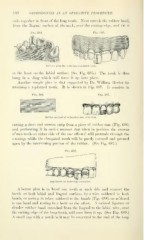Page 732 - My FlipBook
P. 732
30 OliTIIODOyriA AS Ay OriniATlVE rilOCEDURE.
ends toijethcr in front of the long tooth. Next stretch the rubber band,
from the lingual surface of the neck, over the cutting edge, and tie it
Fig. 684. Fig. 085.
i4 ''
Writer's plan for reducnn^ extruded teeth.
to the knot on the labial surface. (See Fig. 685.) The tooth is thus
hung in a sling whicli will force it up into place.
Another simple plan is that suggested by Dr. William Herbst for
retaining a replanted tooth. It is shown in Fig. 687. It consists in
Fig. 686. Fig. 687.
Herbst method of reduction and retention.
cutting a short and narrow strip from a piece of rubber dam (Fig. 686)
and perforating it in such a manner that when in position the crowns
of two teeth on either side of the one affected will protrude through the
openings while the elongated tooth will be partly covered and pressed
upon by the intervening portion of the rubl)er. (See Fig. 687.)
Fig. 688.
Appliance for reducing extrusion.
A better plan is to band one tooth on each side and connect the
bands on both labial and lingual surfaces by a wire soldered to both
bands, or resting in tubes soldered to the bands (Fig. 688), or soldered
to one band and restino^ in a hook on the other. A twisted limiture or
slender rubber band stretched from the lingual to the labial wire, over
the cutting edge of the hmg tooth, will soon force it up. (See Fig. 689.)
A small cap with a notch in it may be cemented to the end of the long


